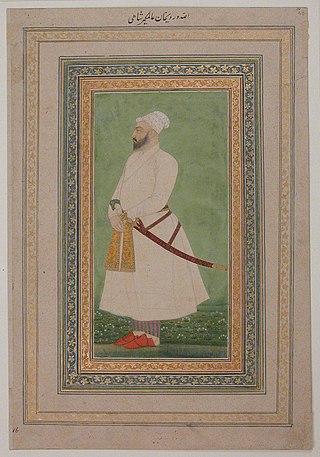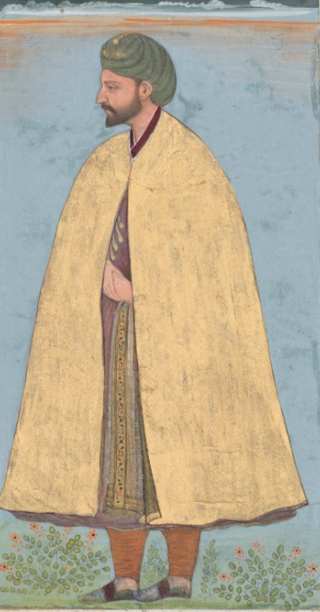Related Research Articles

Alamut is a mountain fortress at an altitude of 2163 meters at the central Alborz, in the Iranian stanza of Qazvin, about 100 kilometers from Tehran. In 1090 AD, the Alamut Castle, a mountain fortress in present-day Iran, came into the possession of Hassan-i Sabbah, a champion of the Nizari Ismaili cause. Until 1256, Alamut functioned as the headquarters of the Nizari Ismaili state, which included a series of strategic strongholds scattered throughout Persia and Syria, with each stronghold being surrounded by swathes of hostile territory.

Ibrahim Qutb Shah Wali, also known by his Telugu names Malki BhaRama and Ibharama Chakravarti, was the fourth monarch of the kingdom of Golconda in southern India. He was the first of the Qutb Shahi dynasty to use the title "Sultan". He ruled from 1550 to 1580. He lived for seven years in exile at the court of Vijayanagara as an honoured guest of Rama Raya. Ibrahim is known for patronizing Telugu extensively because he was moved by a genuine love for the language.

François Bernier was a French physician and traveller. He was born in Joué-Etiau in Anjou. He stayed for around 12 years in India.
Haji Muhammad Mohsin was a prominent Bengali Muslim philanthropist. His most notable contribution was to establish the Hooghly Mohsin College and the Hooghly Imambara. He also played a significant role during the Great Bengal famine of 1770 by helping thousands of the victims.

Alivardi Khan was the Nawab of Bengal from 1740 to 1756. He toppled the Nasiri dynasty of Nawabs by defeating Sarfaraz Khan in 1740 and assumed power himself.
Shah Abdul Aziz Muhaddith Dehlavi was an Indian Sunni Muslim Scholar and Sufi Saint. He is known as the Muhaddith and Mujaddid from India. He was of the Naqshbandi Sufi order which emerged from a tradition of violent backlash against the modernization of Sunni culture. This tradition inspired later Sunni scholarship, including Abdul Aziz's father Shah Waliullah Dehlawi. Aziz's dream was to declare India a Darul Harb.
Subhan Ali Khan Kamboh was an Indian Muslim scholar.
The five Martyrs were five scholars (ulama) of Shi'i Islam, living in different spans of history, who were executed by their respective Sunni regimes. The Shia remember them by the term Five Martyrs. A leading work on the biographies of the martyrs was Shuhada-e Khamsa kay Halaat-e Zindagi by Grand Ayatollah Muhammad Hussain Najafi.
Shia Islam was brought to the Indian subcontinent during the final years of the Rashidun Caliphate. The Indian subcontinent also served as a refuge for some Shias escaping persecution from Umayyads, Abbasids, Ayyubids, and Ottomans. The immigration continued throughout the second millennium until the formation of modern nation states. Shi'ism also won converts among the local population.
The History of Nizari Isma'ilism from the founding of Islam covers a period of over 1400 years. It begins with Muhammad's mission to restore to humanity the universality and knowledge of the oneness of the divine within the Abrahamic tradition, through the final message and what the Shia believe was the appointment of Ali as successor and guardian of that message with both the spiritual and temporal authority of Muhammad through the institution of the Imamate.
The Abaqati family is a sub-branch of the Jarwal-Kintoor branch of Nishapuri Kazmi-Musavi Sayeds who trace their lineage to the Islamic prophet Muhammad through the eldest son of the great-grandson of Musa al-Kadhim, he was given a jagir in Jarwal-Kintoor by Sultan Muhammad Tughluq, his other two brothers were given jagirs in Budgam, Kashmir and Sylhet, Bengal.

Qutb ud-Din Ahmad ibn ʿAbd-ur-Rahim al-ʿUmari ad-Dehlawi, commonly known as Shah Waliullah Dehlawi, was an Islamic Sunni scholar and Sufi of the Naqshbandi order, who is seen by his followers as a renewer. He emphasized the importance of following Sharia and believed in the unification of Hanafi and Shafi'i schools of law, aiming to reduce legal differences.
By the late 11th century, the Shi'a sub-sect of Ismailism had found many adherents in Persia, although the region was occupied by the Sunni Seljuk Empire. The hostile tendencies of the Abbasid–Seljuk order triggered a revolt by Ismailis in Persia under Hassan-i Sabbah. Siege of Maysaf

Moulvi Muhammad Baqir (1780–1857) was a scholar, an Indian independence activist and journalist based in Delhi. He was the first journalist to be executed following rebellion in 1857. He was arrested on 16 September 1857 and executed by gunshot two days later without trial.
The Madhe Sahaba Agitation was a civil disobedience movement launched by Deobandi Muslims of Lucknow in the first half of the twentieth century to counter the commemoration of the tragedy of Karbala during Muharram. It resulted in a widespread Shia-Sunni conflict between the years 1906 – 1909 and turned violent in 1936 – 1939. The conflict spread to other parts of British India.
Saiyid Athar Abbas Rizvi (1921–1994) was a modern historian of medieval India, mainly focused on history of Islam in South Asia.

Tafazzul Husain Khan Kashmiri (1727–1801), also known as Khan-e-Allama, was a Twelver Shia scholar, physicist, and philosopher. He produced an Arabic translation of Sir Isaac Newton's Principia.
The Qazi family of Lakhnauti was a medieval Bengali Muslim family who lived in the royal city of Lakhnauti in the Bengal Sultanate. The family was founded by Taj ad-Din an-Nahwi in the 15th century, and has produced numerous influential judges and scholars. The descendants of Shah Manjhan later moved to Gujarat and neighbouring states.

Najib al-Din Humayun, commonly known as Hakim Humam or Hakim Hamam, was a physician (hakim) and an official in the service of the Mughal emperor Akbar. A native of Gilan in present-day Iran, he migrated to present-day India with his brothers because of Safavid persecution. He held several positions in Akbar's service, and served as the Mughal ambassador to Abdullah Khan II of Bukhara.
References
- ↑ Saiyid Athar Abbas Rizvi, "A Socio-Intellectual History of Isna Ashari Shi'is in India", Vol. 1, p. 282, Ma’rifat Publishing House, Canberra, Australia (1986).
- ↑ Reza Pourjavady, " Philosophy in Early Safavid Iran: Najm al-Din Mahmud Al-Nayrizi and His Writings ", p. 39, BRILL, (2011).
- ↑ Saiyid Athar Abbas Rizvi, "A Socio-Intellectual History of Isna Ashari Shi'is in India", Vol. 1, p. 283, Ma’rifat Publishing House, Canberra, Australia (1986).
- ↑ Saiyid Athar Abbas Rizvi, "A Socio-Intellectual History of Isna Ashari Shi'is in India", Vol. 1, p. 286, Ma’rifat Publishing House, Canberra, Australia (1986).
- ↑ John Norman Hollister, "The Shi'a of India", p. 117, Luzac and Co., London (1953).
- ↑ W. Ivanow, A Forgotten Branch of the Ismailis. The Journal of the Royal Asiatic Society of Great Britain and Ireland, No. 1 (January 1938).
- 1 2 Saiyid Athar Abbas Rizvi, "A Socio-Intellectual History of Isna Ashari Shi'is in India", Vol. 1, p. 290, Ma’rifat Publishing House, Canberra, Australia (1986).
- ↑ Daftary, Farhad (2021). "Husayni, Shah Tahir b. Radi al-Din (d. 956 AH/ 1549 CE)". The Institute of Ismaili Studies.